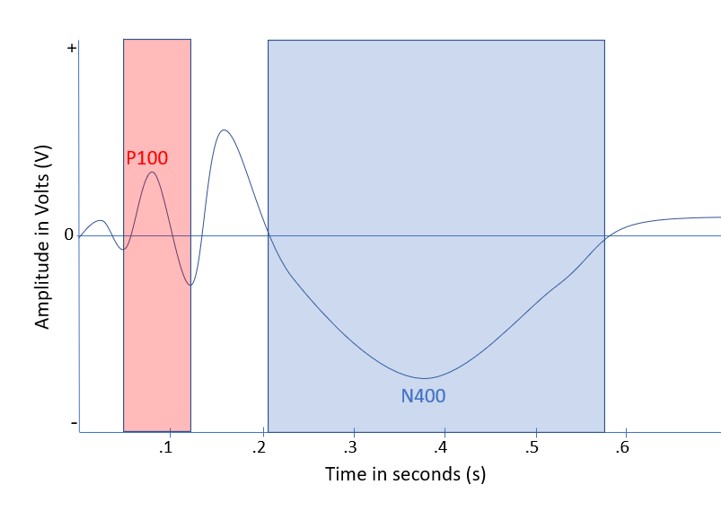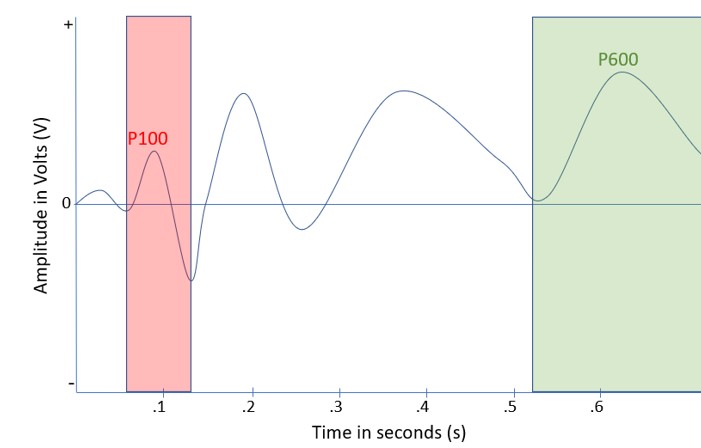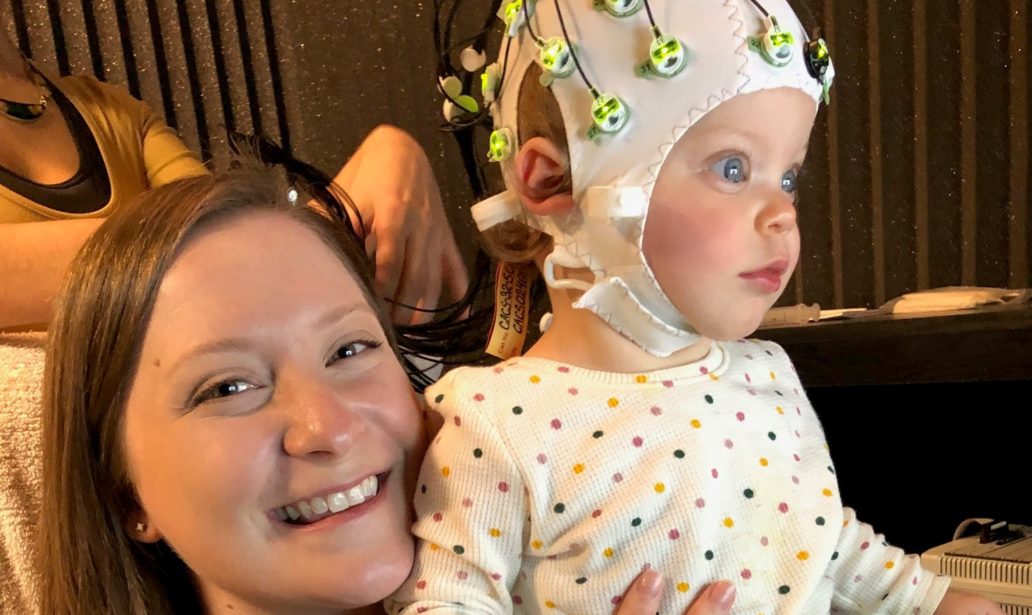When we measure baby brainwaves, what do we measure and what does it mean?
When scientists measure brainwaves, they find a lot of them happening at different times. Scientists call these waves components, but we will continue to call them waves in this post. Some of the waves show up because the participant is processing language, while others happen for other reasons. Here are three specific EEG waves that some linguists use to learn about babies learning language, and what they mean. They are called the P100, the N400, and the P600. Each of these is named for whether the wave points up (P for positive) or down (N for negative), and how long it takes for the wave to crest.
|
Emilia – Courtesy of parent. |
The P100:
The P100 is one of the quickest waves. It is positive and happens about one-tenth of a second (100 ms) after a person notices something, like a sound, an image, or a word.
Some waves result from automatic processes in the brain, and others result from more complex thinking. The P100 is a very early peak, so it is believed to result from an automatic process in the brain.
The N400:
The N400 is another wave.It is a sign that the brain started having difficulty understanding what was going on. It is a long-lasting negative wave that crests a little less than half of a second (400 ms) after a person sees or hears something meaningful but with a surprising or confusing twist at the end.
For example, when you read the sentence “Yesterday, I gave a haircut to my Toyota,” you’d have an N400 about four words after “Toyota” (a little less than a half-second). The N400 would happen because this sentence is made obviously nonsensical by that word, so you struggled to make meaning out of it.
The N400 takes longer than the P100 because the N400 is created by more complex brain activity than that of the P100.
In research settings, this effect can be found when using eyes to read, look at pictures, or see view sign language sentences. It can also be found when using ears to listen to sentences or environmental sounds that are easily identifiable like a horse clopping against cobblestones, if there is information that makes things stop making sense.

The P100 and the N400.
The P600:
The P600 is the third most common wave. It happens after someone notices a grammar issue.
For example, after reading the sentence “I convinced her children are smart,” you would probably have a P600 after about five words beyond the end of the sentence (a little over a half-second, or 600 ms). This is because you expected to read “I convinced her children of something” instead of “I convinced her that children are smart.” You had to go back and re-understand the meaning of the sentence.
The sentence above is grammatically correct, but it would usually make a P600. This shows that the issue doesn’t need to be a grammatical mistake. In fact, the P600 happens after something grammatically unexpected happens. This could be something like a suddenly complex sentence, a sentence construction that is not preferred, or an error.
The P600 is important to language studies, but it’s even been shown to occur outside of linguistic situations! Researchers have been able to find it in certain situations when participants are working on math problems, listening to music, and other tasks that involve a mostly-predictable structure that gets violated.

These three waves are helpful for researchers who are investigating what people know or what people expect when listening to or reading language. They happen as long as the experiment participant understands the language. If a baby doesn’t understand a language at all, not all of the waves will appear. Researchers look at the size of the waves, and whether or not they even happen to find out what people (including babies) know!
For more details from a cognitive science expert, check out this paper by Anna Beres below!
Beres, A. M. (2017). Time is of the essence: A review of electroencephalography (EEG) and event-related brain potentials (ERPs) in language research. Applied Psychophysiology and Biofeedback, 42(4), 247–255. https://doi.org/10.1007/s10484-017-9371-3.

Aahnix Bathurst
Editor/publisher
Aahnix is a Project Coordinator in the Bergelson lab at Duke University
